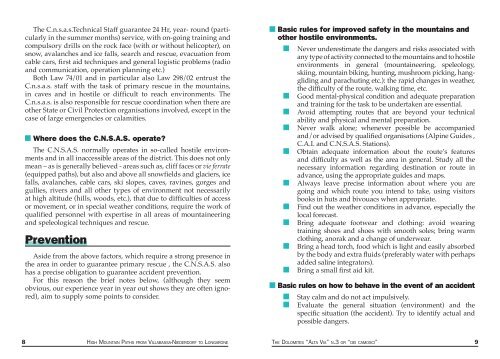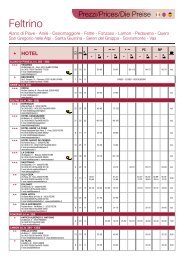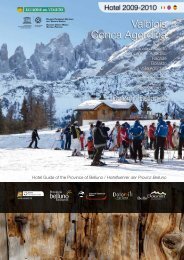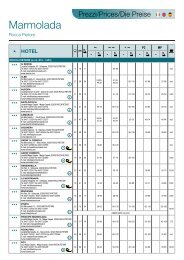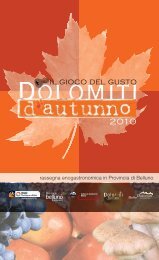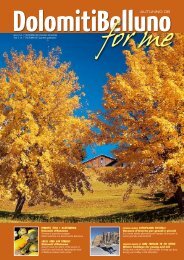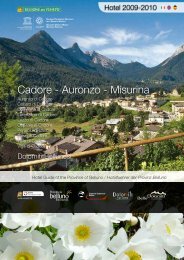Copertina inglese.indd - Dolomiti
Copertina inglese.indd - Dolomiti
Copertina inglese.indd - Dolomiti
Create successful ePaper yourself
Turn your PDF publications into a flip-book with our unique Google optimized e-Paper software.
The C.n.s.a.s.Technical Staff guarantee 24 Hr, year- round (particularly<br />
in the summer months) service, with on-going training and<br />
compulsory drills on the rock face (with or without helicopter), on<br />
snow, avalanches and ice falls, search and rescue, evacuation from<br />
cable cars, first aid techniques and general logistic problems (radio<br />
and communication, operation planning etc.)<br />
Both Law 74/01 and in particular also Law 298/02 entrust the<br />
C.n.s.a.s. staff with the task of primary rescue in the mountains,<br />
in caves and in hostile or difficult to reach environments. The<br />
C.n.s.a.s. is also responsible for rescue coordination when there are<br />
other State or Civil Protection organisations involved, except in the<br />
case of large emergencies or calamities.<br />
Where does the C.N.S.A.S. operate?<br />
The C.N.S.A.S. normally operates in so-called hostile environments<br />
and in all inaccessible areas of the district. This does not only<br />
mean – as is generally believed - areas such as, cliff faces or vie ferrate<br />
(equipped paths), but also and above all snowfields and glaciers, ice<br />
falls, avalanches, cable cars, ski slopes, caves, ravines, gorges and<br />
gullies, rivers and all other types of environment not necessarily<br />
at high altitude (hills, woods, etc.), that due to difficulties of access<br />
or movement, or in special weather conditions, require the work of<br />
qualified personnel with expertise in all areas of mountaineering<br />
and speleological techniques and rescue.<br />
Prevention<br />
Aside from the above factors, which require a strong presence in<br />
the area in order to guarantee primary rescue , the C.N.S.A.S. also<br />
has a precise obligation to guarantee accident prevention.<br />
For this reason the brief notes below, (although they seem<br />
obvious, our experience year in year out shows they are often ignored),<br />
aim to supply some points to consider.<br />
Basic rules for improved safety in the mountains and<br />
other hostile environments.<br />
Never underestimate the dangers and risks associated with<br />
any type of activity connected to the mountains and to hostile<br />
environments in general (mountaineering, speleology,<br />
skiing, mountain biking, hunting, mushroom picking, hanggliding<br />
and parachuting etc.): the rapid changes in weather,<br />
the difficulty of the route, walking time, etc.<br />
Good mental-physical condition and adequate preparation<br />
and training for the task to be undertaken are essential.<br />
Avoid attempting routes that are beyond your technical<br />
ability and physical and mental preparation.<br />
Never walk alone; whenever possible be accompanied<br />
and/or advised by qualified organisations (Alpine Guides ,<br />
C.A.I. and C.N.S.A.S. Stations).<br />
Obtain adequate information about the route’s features<br />
and difficulty as well as the area in general. Study all the<br />
necessary information regarding destination or route in<br />
advance, using the appropriate guides and maps.<br />
Always leave precise information about where you are<br />
going and which route you intend to take, using visitors<br />
books in huts and bivouacs when appropriate.<br />
Find out the weather conditions in advance, especially the<br />
local forecast.<br />
Bring adequate footwear and clothing: avoid wearing<br />
training shoes and shoes with smooth soles; bring warm<br />
clothing, anorak and a change of underwear.<br />
Bring a head torch, food which is light and easily absorbed<br />
by the body and extra fluids (preferably water with perhaps<br />
added saline integrators).<br />
Bring a small first aid kit.<br />
Basic rules on how to behave in the event of an accident<br />
Stay calm and do not act impulsively.<br />
Evaluate the general situation (environment) and the<br />
specific situation (the accident). Try to identify actual and<br />
possible dangers.<br />
8 HIGH MOUNTAIN PATHS FROM VILLABASSA-NIEDERDORF TO LONGARONE THE DOLOMITES “ALTA VIA” N.3 OR “DEI CAMOSCI” 9


